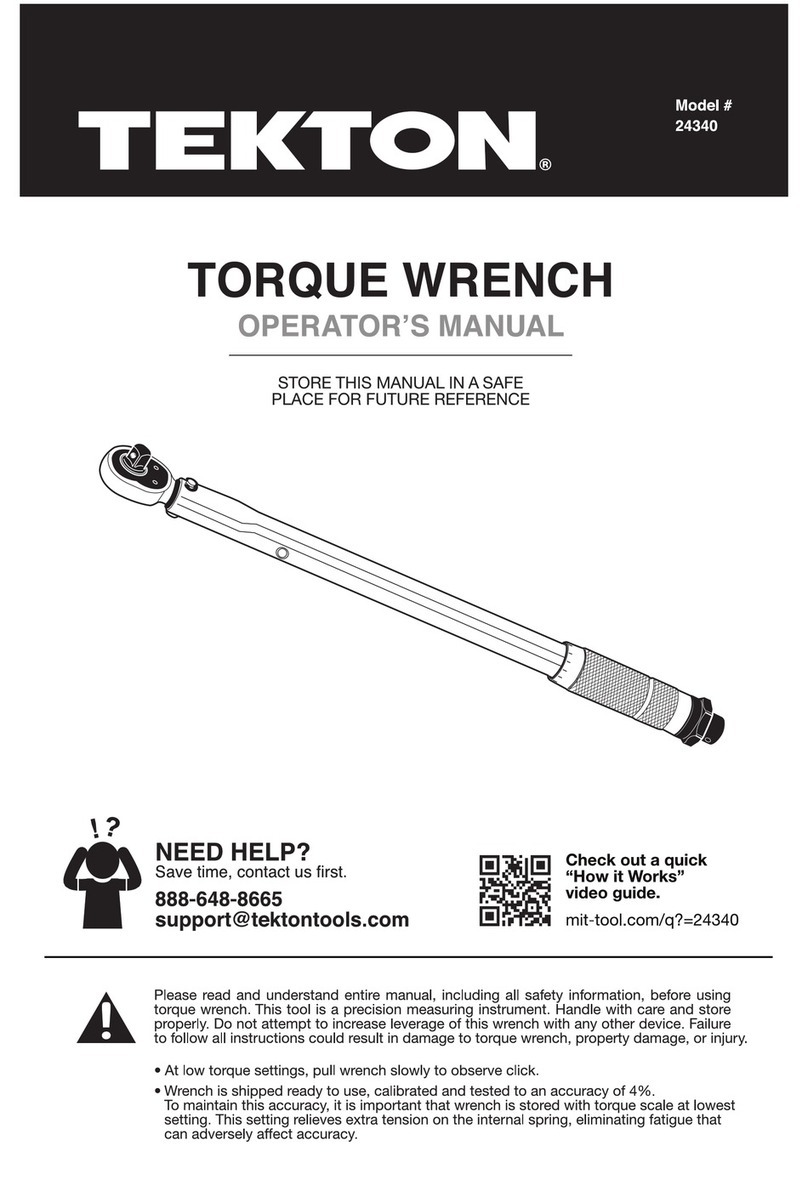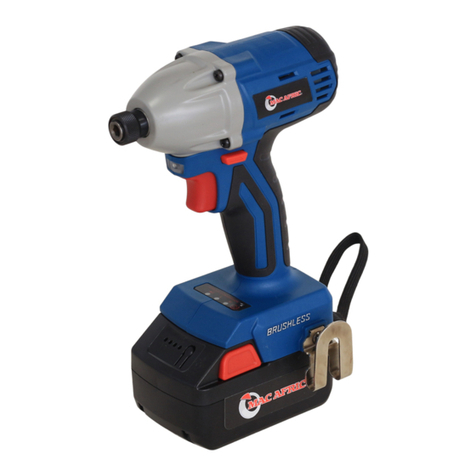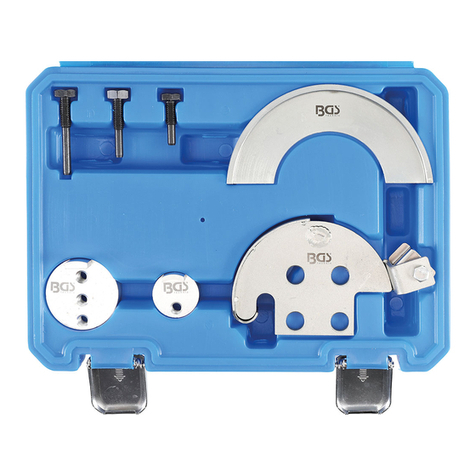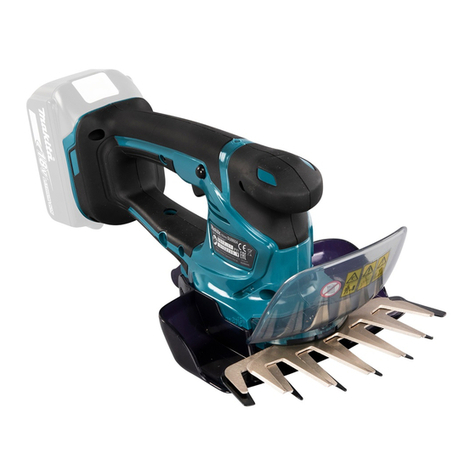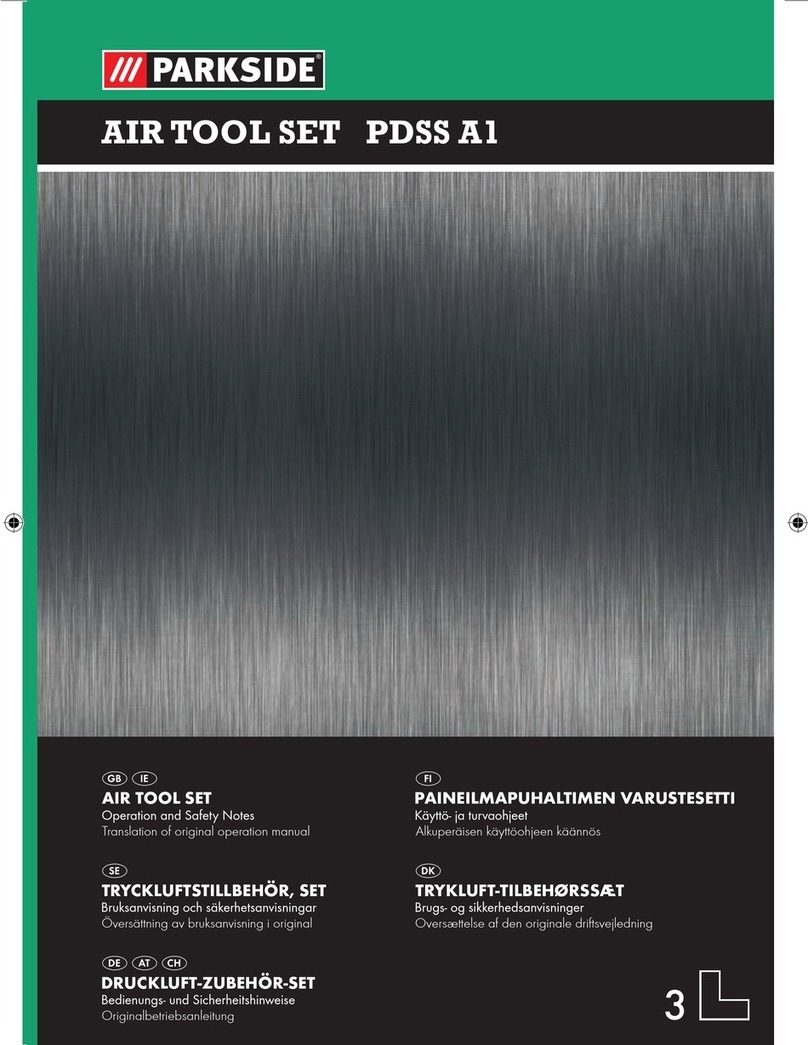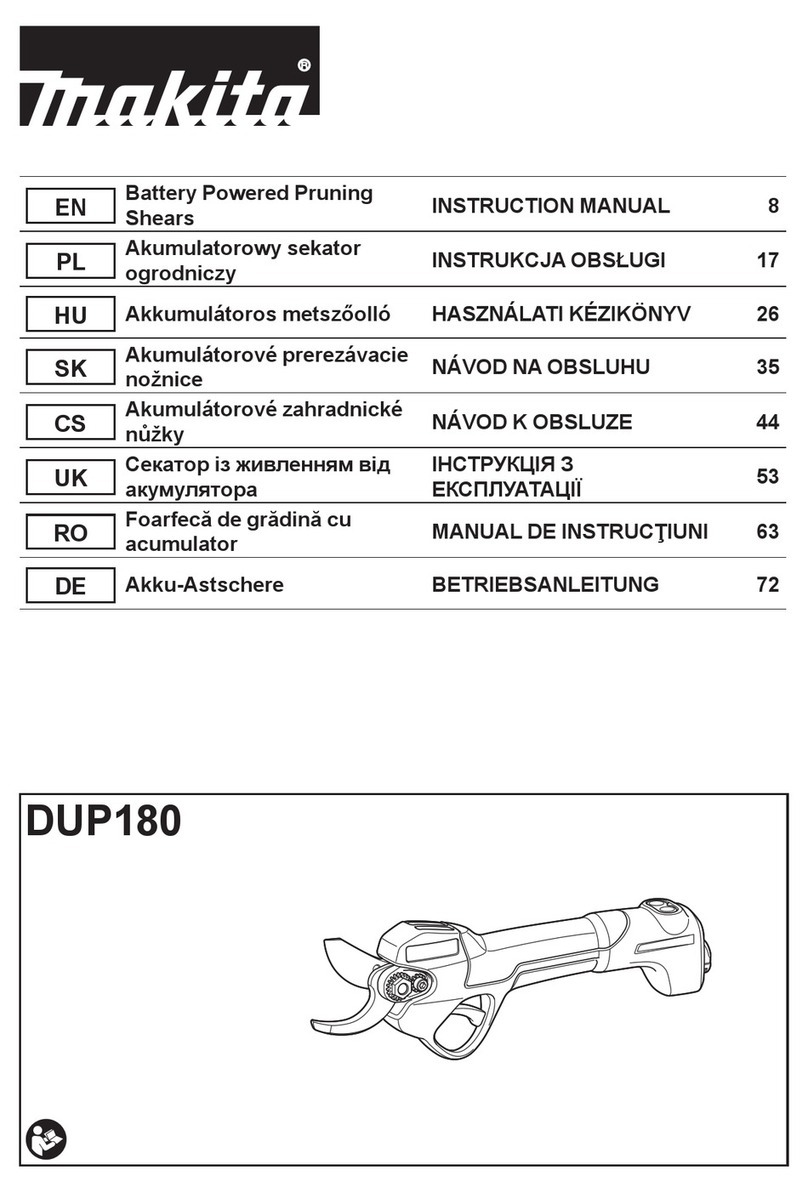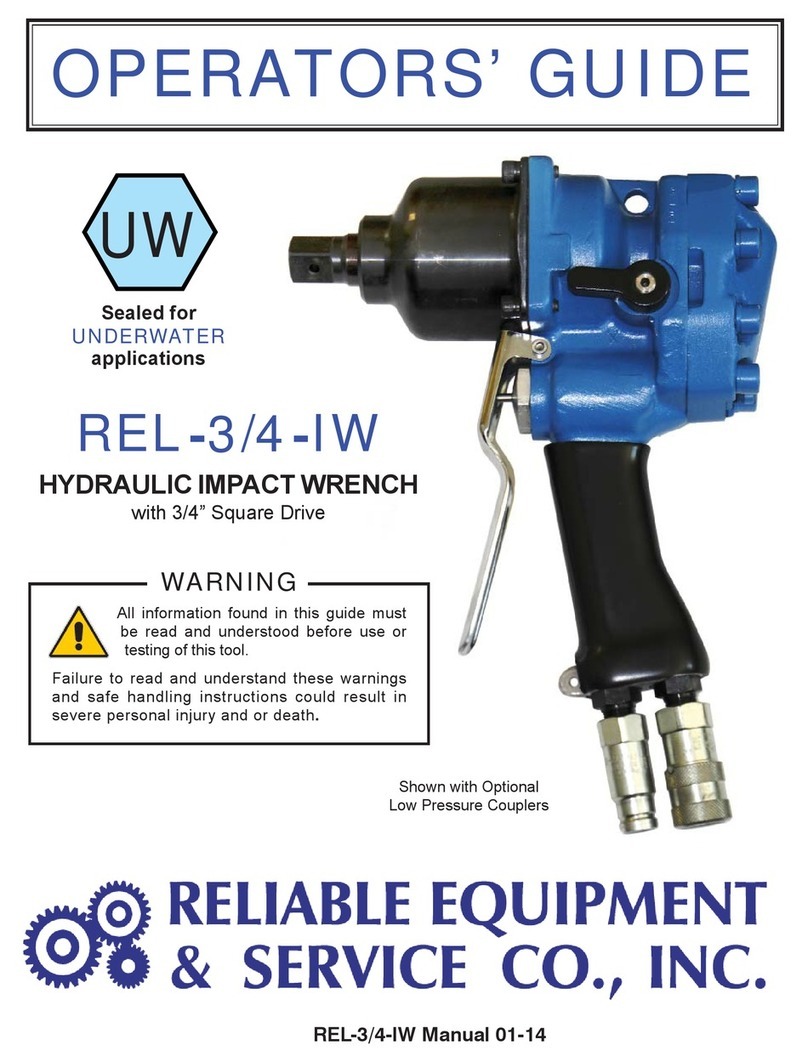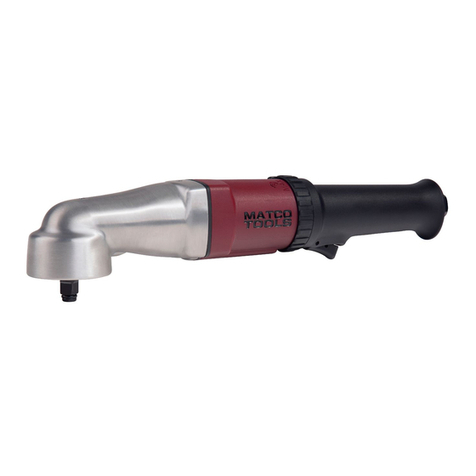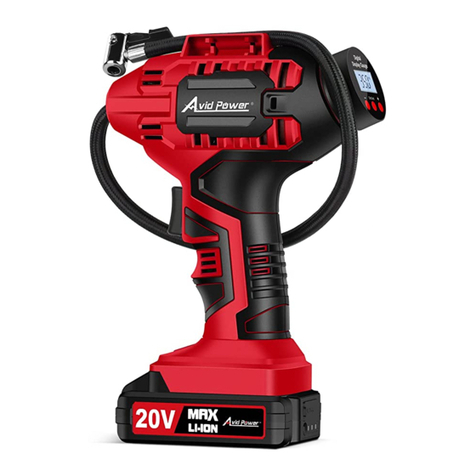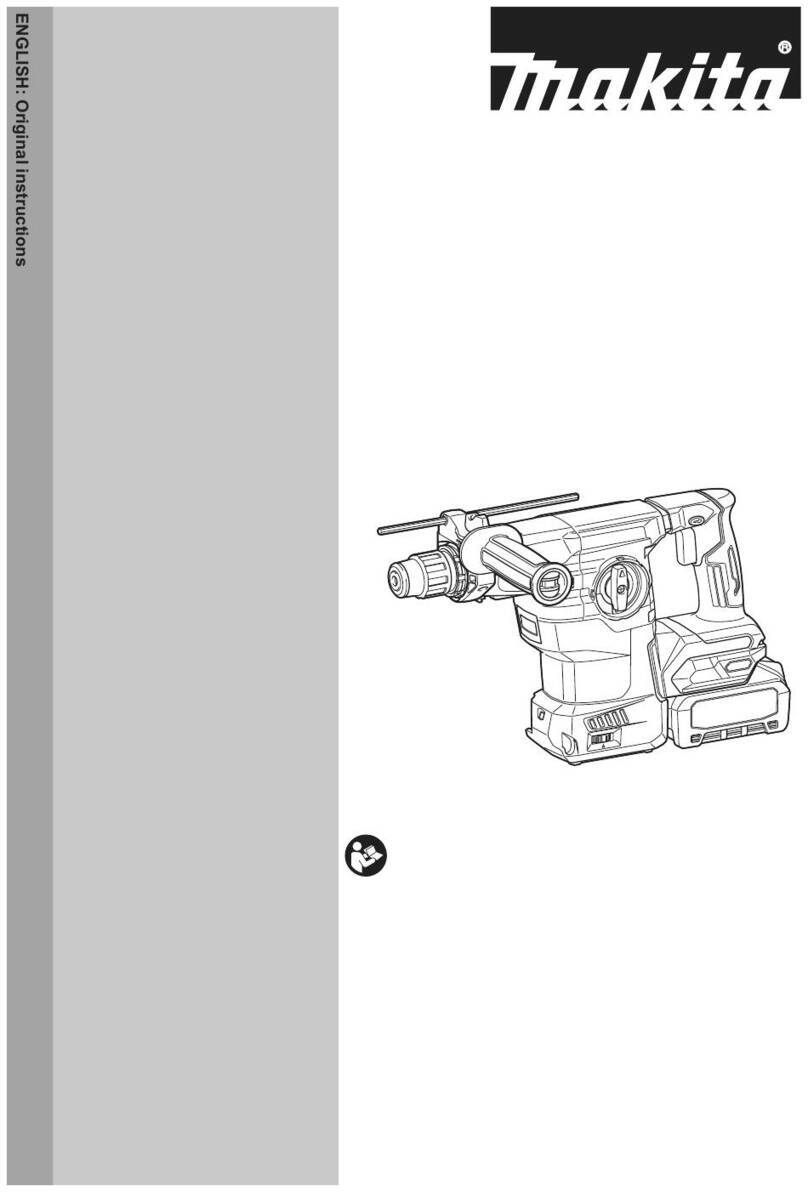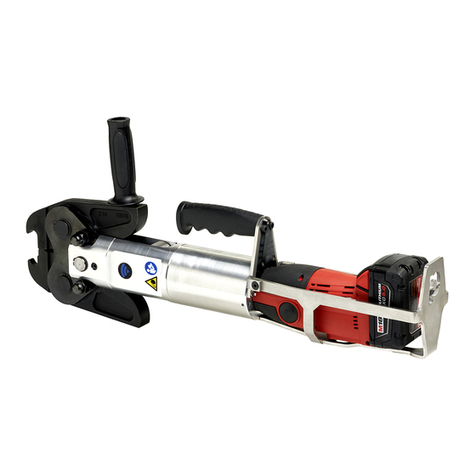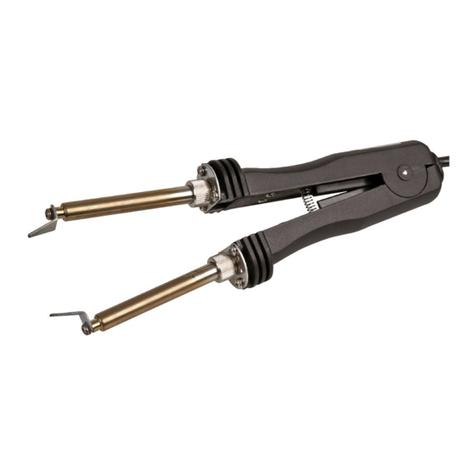DeKo DKBW20XL01 User manual

INSTRUCTION MANUAL
CORDLESS IMPACT WRENCH
Model No.: DKBW20XL01
DEKO TOOLS CO., LIMITED
www.dekotools.com Made in China
IMPORTANT:
Read this instruction manual before operating this product.
Keep the instruction manual for future reference.

General Power Tool Safety Warnings
WARNING: Read all safety warnings, instructions, illustra-
tions and specifications provided with this power tool. Failure to
follow all instructions listed below may result in electric shock, fire
and/or serious injury.
Save all warnings and instructions for future reference.
The term "power tool" in the warnings refers to your mains-operated
(corded) power tool or battery-operated (cordless) power tool.
WARNING:
1) Work area safety
a) Keep work area clean and well lit. Cluttered or dark areas invite
accidents.
b) Do not operate power tools in explosive atmospheres, such as
in the presence of flammable liquids, gases or dust. Power tools
create sparks which may ignite the dust or fumes.
c) Keep children and bystanders away while operating a power
tool. Distractions can cause you to lose control.
2) Electrical safety
a) Power tool plugs must match the outlet. Never modify the plug
in any way. Do not use any adapter plugs with earthed (grounded)
power tools. Unmodified plugs and matching outlets will reduce
risk of electric shock.
b) Avoid body contact with earthed or grounded surfaces, such
as pipes, radiators, ranges and refrigerators. There is an
increased risk of electric shock if your body is earthed or ground-
ed.
c) Do not expose power tools to rain or wet conditions. Water
entering a power tool will increase the risk of electric shock.
d) Do not abuse the cord. Never use the cord for carrying, pulling
or unplugging the power tool.
Keep cord away from heat, oil, sharp edges or moving parts.
Damaged or entangled cords increase the risk of electric shock.

e) When operating a power tool outdoors, use an extension cord suit-
able for outdoor use. Use of a cord suitable for outdoor use reduces
the risk of electric shock.
f) If operating a power tool in a damp location is unavoidable, use a
residual current device (RCD) protected supply. Use of an RCD reduc-
es the risk of electric shock.
3) Personal safety
a) Stay alert, watch what you are doing and use common sense when
operating a power tool. Do not use a power tool while you are tired or
under the influence of drugs, alcohol or medication. A moment of
inattention while operating power tools may result in serious person-
al injury.
b) Use personal protective equipment. Always wear eye protection.
Protective equipment such as a dust mask, non-skid safety shoes,
hard hat or hearing protection used for appropriate conditions will
reduce personal injuries.
c) Prevent unintentional starting. Ensure the switch is in the off-posi-
tion before connecting to power source and/or battery pack, picking
up or carrying the tool. Carrying power tools with your finger on the
switch or energising power tools that have the switch on invites acci-
dents.
d) Remove any adjusting key or wrench before turning the power tool
on. A wrench or a key left attached to a rotating part of the power tool
may result in personal injury.
e) Do not overreach. Keep proper footing and balance at all times.
This enables better control of the power tool in unexpected situa-
tions.
f) Dress properly. Do not wear loose clothing or jewellery. Keep your
hair and clothing away from moving parts. Loose clothes, jewellery or
long hair can be caught in moving parts.
g) If devices are provided for the connection of dust extraction and
collection facilities, ensure these are connected and properly used.

Use of dust collection can reduce dust-related hazards.
h) Do not let familiarity gained from frequent use of tools allow you to
become complacent and ignore tool safety principles. A careless
action can cause severe injury within a fraction of a second.
4) Power tool use and care
a) Do not force the power tool. Use the correct power tool for your
application. The correct power tool will do the job better and safer at
the rate for which it was designed.
b) Do not use the power tool if the switch does not turn it on and off.
Any power tool that cannot be controlled with the switch is danger-
ous and must be repaired.
c) Disconnect the plug from the power source and/or remove the
battery pack, if detachable, from the power tool before making any
adjustments, changing accessories, or storing power tools. Such
preventive safety measures reduce the risk of starting the power tool
accidentally.
d) Store idle power tools out of the reach of children and do not allow
persons unfamiliar with the
power tool or these instructions to operate the power tool. Power
tools are dangerous in the hands of untrained users.
e) Maintain power tools and accessories. Check for misalignment or
binding of moving parts, breakage of parts and any other condition
that may affect the power tool’s operation. If damaged, have the
power tool repaired before use. Many accidents are caused by poorly
maintained power tools.
f) Keep cutting tools sharp and clean. Properly maintained cutting
tools with sharp cutting edges are less likely to bind and are easier to
control.
g) Use the power tool, accessories and tool bits etc. in accordance
with these instructions, taking into account the working conditions
and the work to be performed. Use of the power tool for operations
different from those intended could result in a hazardous situation.

h) Keep handles and grasping surfaces dry, clean and free from oil
and grease. Slippery handles and grasping surfaces do not allow for
safe handling and control of the tool in unexpected situations.
5) Battery tool use and care.
a) Recharge only with the charger specified by the manufacturer. A
charger that is suitable for one type of battery pack may create a risk
of fire when used with another battery pack.
b) Use power tools only with specifically designated battery packs.
Use of any other battery packs may create a risk of injury and fire.
c) When battery pack is not in use, keep it away from other metal
objects, like paper clips, coins, keys, nails, screws or other small
metal objects, that can make a connection from one terminal to
another. Shorting the battery terminals together may cause burns or
a fire.
d) Under abusive conditions, liquid may be ejected from the battery;
avoid contact. If contact accidentally occurs, flush with water. If
liquid contacts eyes, additionally seek medical help. Liquid ejected
from the battery may cause irritation or burns.
e) Do not use a battery pack or tool that is damaged or modified.
Damaged or modified batteries
may exhibit unpredictable behaviour resulting in fire, explosion or risk
of injury.
f) Do not expose a battery pack or tool to fire or excessive tempera-
ture . Exposure to fire or temperature above 40 °C may cause explosion.
g) Follow all charging instructions and do not charge the battery pack
or tool outside the temperature range specified in the instructions.
Charging improperly or at temperatures outside the specified range
may damage the battery and increase the risk of fire.
6) Service
a) Have your power tool serviced by a qualified repair person using
only identical replacement parts. This will ensure that the safety of the
power tool is maintained.

1) Before any work on the machine (e.G., Maintenance, tool change,
etc.) as well as during transport and storage, set the rotational
direction switch (forward/reverse switch ) to the center position.
Unintentional actuation of the on/off trigger can lead to injuries.
2) Hold power tool by insulated gripping surfaces, when performing
an operation where the cutting accessory or fastener may contact
hidden wiring. Cutting accessory and fasteners contacting a “live”
wire may make exposed metal parts of the power tool “live” and could
give the operator an electric shock.
3) Wear ear protectors and goggles when impact drilling. Exposure
to noise can cause hearing loss.
4) Dusts from materials such as lead-containing coatings, some
wood types, minerals and metal can be harmful to one’s health and
cause allergic reactions, lead to respiratory infections and/or
cancer. Materials containing asbestos may only be worked by special-
ists.
– please always keep the working place clean and well-ventilated.
– it is recommended to wear dust masks that are specially designed
to filter out microscopic particles.
Observe the relevant regulations in your country for the materials to be
worked.
5) Use only sockets and other accessories specifically designed for
use on impact wrenches and drivers. Other sockets and accessories
might shatter or break causing injury.
6) Always use common sense and be cautious when using tools. It
is not possible to anticipate every situation that could result in a
dangerous outcome. Do not use this tool if you do not understand
these operating instructions or you feel the work is beyond your capa-
bility.
Specific Safety Rules For Impact Wrenches

Save These Instructions for Future Use
Symbols Explanation in the Manual and/or on the Drill and Battery.
Denotes risk of personal injury or damage to the tool.
It is environmental friendly and could be recycled
Do not dispose of power tools and batteries/rechargeable
batteries into household waste! Dispose the products
according to the regulation and requirement of local council.
Keep the battery away from the fire.
Keep the battery away from moisture or water.
Read instruction manual before use.
Conforms to relevant safety standards.
Do not dispose of old appliances with domestic rubbish.
MAX.40
Charging temperature do not exceed 40°C
Production Specification
Model No.
Rated voltage DC 20V
0-1000/1800/2450/min (RPM)
No load speed
Impacts per minute
DKBW20XL01
0-3200/min (IPM)
Max torque 350 N.m
Anvil size 13mm (1/2”)

Parts Description
1. Anvil (1/2",13mm)
2. LED worklight
3. Forward/reverse switch
4. Speed on/off control trigger
5. Handle
6. Mode indicator
7. Function switch
8. Battery pack release button
9. Battery pack
10. Screw
11. Belt hook
12. Charing input port.
15. Indicator light
Red light--- in charge
Green light- fully charged
13
15
14
12
3
4
1
5
9
8
2
6
7
10
11
13. Battery indicator
14. Adapter/Charger
9

Intended Use
This impact wrench is designed for loosening/tightening bolts
and nuts.
Forward/Reverse Switch & Function Mode
This wrench features 3 modes/speeds to tighten bolts and 2
modes to loosen bolts. Each mode stands for different speeds
and forces. Users shall choose the appropriate mode to fit differ-
ent applications
WARNING: Use only sockets and other accessories specifically
designed for use on impact wrenches and drivers. Other sockets
and accessories might shatter or break causing injury.
a) Selecting mode in forward rotation to tighten bolts
1. Select the forward rotation by push the forward/reverse
switch (3) to the left.
2. Press the function switch (7) to change low/medium/high
mode. The mode indicator will emit green light. 1 stands for low
mode, 2 for medium mode and 3 for high mode. Users shall
select suitable modes for different tasks.
1. Select the reverse rotation by push the forward/reverse switch
(3) to the right.
2. Press the function switch (7) to change the selection of the
self-stop function. The mode indicator S will emit red light.
If the mode indicator (6) is on, the self-stop function is selected.
b) Selecting mode in reverse rotation to loosen bolts

If the mode indicator (6) is off, there is no self-stop function.
3. If the self-stop function is selected, the impact wrench will stop
immediately when it is stalled while unscrewing a bolt or nut. This
will stop the nuts from dropping off and save the battery's power.
Please refer to the following table for the speed and force under
each mode:
Selected mode
1
(Low mode) 0-1000/min
0-1800/min
0-2450/min
0-2450/min
0-1800/min
0-2400/min
0-3200/min
0-3200/min
0-250N.m
0-300N.m
0-350N.m
0-350 N.m
2
(Medium mode)
3
(High mode)
S
(Self-stop mode)
Mode indicator No load speed
(RPM)
Impacts per
minute(IPM) Max. torque
Green light
Green light
Green light
Red light
Red light
Rotational
direction
Forward
direction
Reverse
direction
(Non-stop mode) 0-2450/min 0-3200/min 0-350 N.m

Variable Speed Control Trigger
To turn the tool on, squeeze the speed control trigger (4). To turn
the tool off, release the trigger switch. The chuck will stop as
soon as the trigger switch is fully released.
NOTE: Continuous use in variable speed range is not recommend-
ed. It may damage the switch and should be avoided.
LED Worklight
This drill features an LED worklight (2). This LED worklight could
automatically be turned on when the speed control trigger (4)
is squeezed. The worklight woud delay some seconds after the
release of the speed control trigger (4).
WARNING: The light of this power tool is intended to
illuminate the power tool’s direct area of working operation
and is not suitable for household room illumination.
Belt Hook
This wrench comes together with a belt hook (11) and
a screw (10). Please fix the belt hook onto the wrench if necessary.
Installing and Removing the Battery Pack
NOTE: For best results, make sure your battery pack is fully
charged. To install the battery pack (9) into the tool handle,
align the battery pack with the rails inside the tool’s handle and
slide it into the handle until the battery pack is firmly seated in
the tool and ensure that it does not disengage. To remove the
battery pack from the tool, press the release button (8) and firmly
pull the battery pack out of the tool handle.

Electric Brake
This wrench is fitted with an electric brake system which will stop
the socket rotation after the operator releases the switch trigger.
Battery Charging
Note: The battery is supplied partially charged to prevent possible
problems. Therefore, you should charge it before use. Batteries will
not reach full charge the first time they are charged. Allow several
charging/discharging cycles for them to fully charge.
Release the battery from the tool. Attach the adapter connector to
the charging input port (12) . Whenthe the charger indicator (15) is
in red, the battery is under charging. When the indicator turns green,
the battery is fully charged.
Do not continue to press the On/Off switch after the machine has
been automatically switched off. The battery can be damaged.
The battery is equipped with an NTC temperature control which
allows charging only within a temperature range of between 1
0°C-40°C(50°F-104°F). A long battery service life is achieved in this
manner. Observe the notes for disposal.
Use only original DEKO battery in conjunction with your DEKO power
tool. This measure alone protects the battery against dangerous
overload. When using other batteries, e.g.imitations, reconditioned
batteries, or other brands, there is danger of injury as well as
property damage through exploding batteries.
Residual Risks
Additional residual risks may arise when using the tool which may
not be included in the enclosed safety warnings. These risks can
arise from misuse, prolonged use, etc.
The following hazards may arise while usring the tool:
1, Damage to hearing if effective hearing protection is not worn.
2, Health defects resulting from vibration emission if the power tool
is being used over a longer period of time or not adequately
managed and properly maintained.

3, Injuries caused by touching any rotating/moving parts.
4, Injuries caused when changing any parts, or accessories.
5, Injuries caused by prolonged use of a tool. When using any tool
for prolonged periods, make sure you take regular breaks.
Maintenance and Cleaning
Before any work on the machine (e.g., maintenance, tool change, etc.)
as well as during transport and storage, set the forward/reverse
switch to the center position. Unintentional actuation of the On/Off
switch can lead to injuries.
For safe and proper working, always keep the machine and ventilation
slots clean.
To ensure product SAFETY and RELIABILITY, repairs and any other
maintenance or adjustment should be performed by a qualified repair
person, always using DEKO replacement parts.
Storage
Thoroughly clean the impact wrench and its accessories before
storage.
Store the impact wrench out of the reach of children in a stable and
secure place.
Transport
The contained lithium-ion batteries are subject to the Dangerous
Goods Legislation requirements. The user can transport the
batteries by road without further requirements. Dispatch batteries
only when the housing is undamaged. When being transported by
third parties (e.g.: air transport or forwarding agency), special
requirements on packaging and labelling must be observed.
For the preparation of the item being shipped, please observe
possibly more detailed national regulations and consult an expert
for hazardous material.

Table of contents


